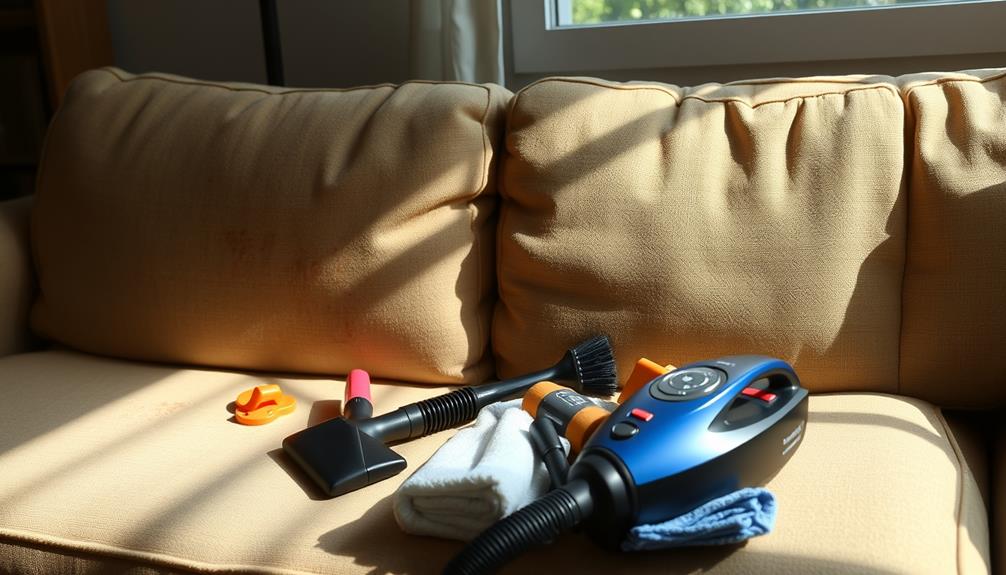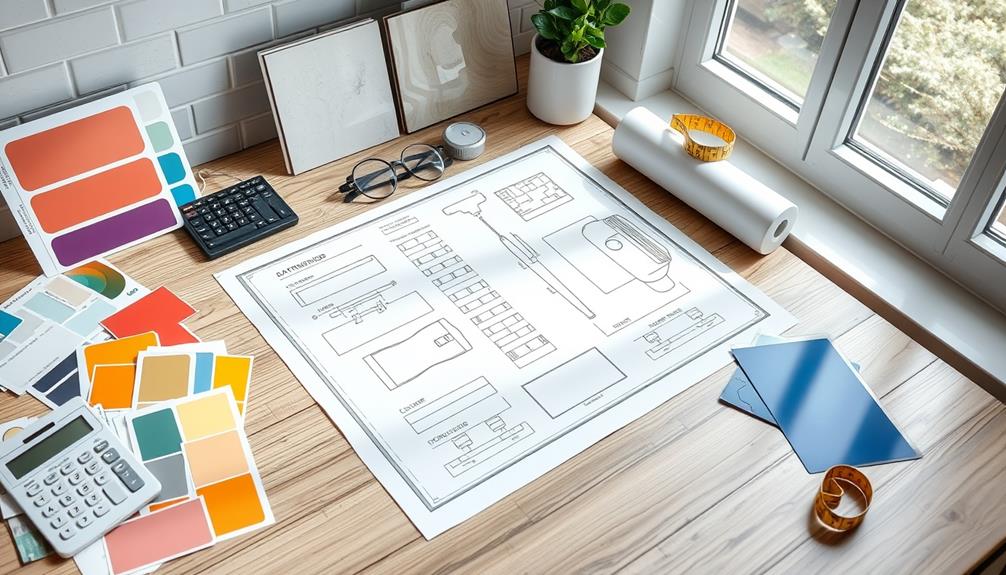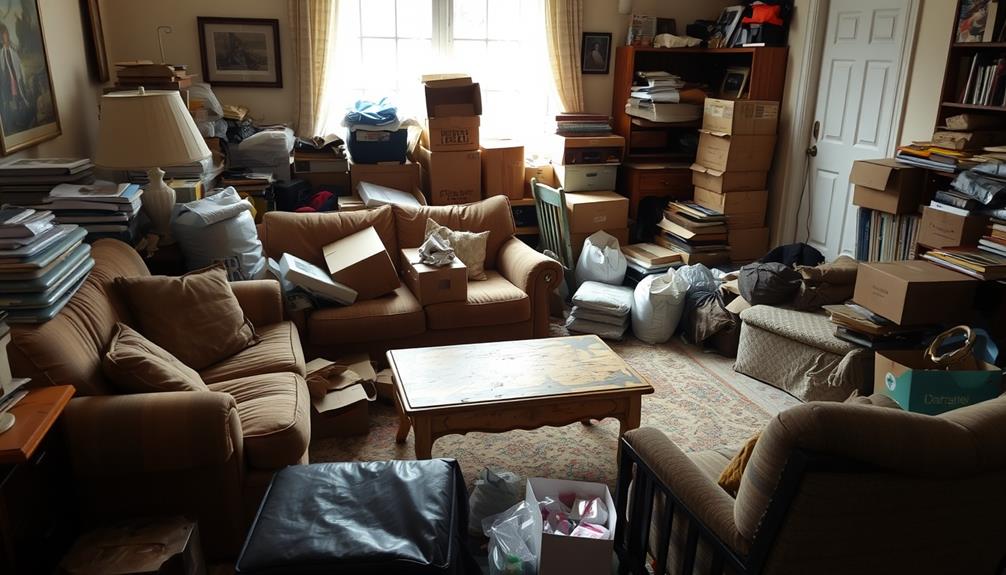To tidy up your sofa upholstery, begin by checking the care tag for cleaning codes. Get the necessary supplies such as a vacuum with a HEPA filter, soft brushes, and DIY cleaners like a mixture of dish soap and warm water. Thoroughly vacuum to eliminate dust and debris. In case of stains, promptly blot and apply the suitable cleaning solution according to the fabric type. Conduct a deep clean regularly using steam or your preferred cleaner, and sprinkle baking soda to get rid of odors. Let the upholstery air dry. There is more to discover about keeping that fresh appearance and feel! To maintain the best look of your sofa, think about rotating the cushions regularly for even wear. Regular maintenance, in addition to spot treatments, will prolong the life of your furniture and help maintain its color and texture. By being proactive with your cleaning upholstery sofa routine, you can relish a fresh and welcoming seating area for years to come.
Key Takeaways
- Identify upholstery cleaning codes on care tags to select appropriate cleaning methods and products.
- Vacuum the sofa thoroughly at least once a month to remove dust and allergens.
- Spot clean stains immediately using the correct solution based on fabric type and stain nature.
- Use DIY cleaning solutions like vinegar and water or dish soap mixed with warm water for general cleaning.
- Deep clean your upholstery at least once or twice a year with a steam cleaner or mild detergent for optimal maintenance.
Understand Upholstery Codes
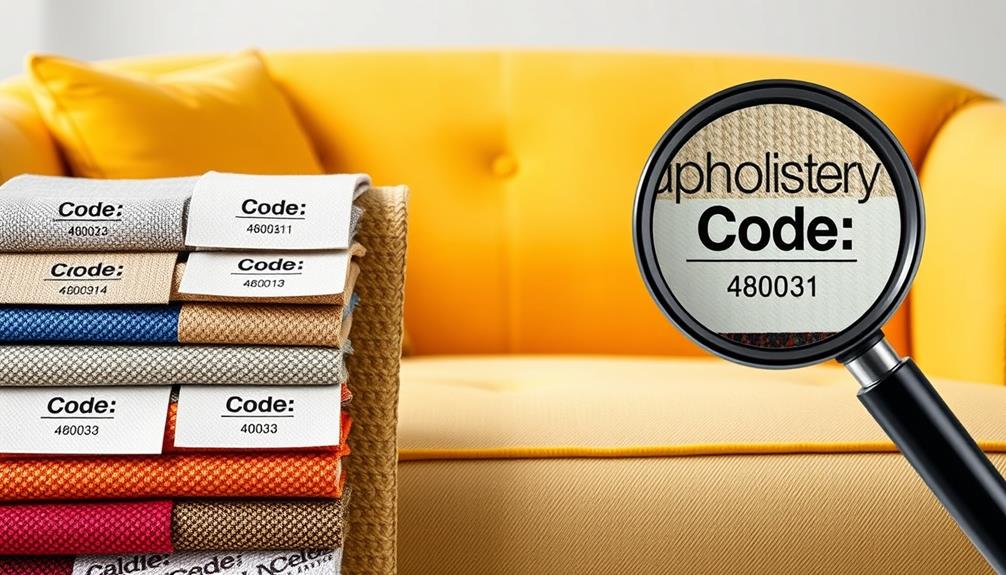
When you're cleaning your sofa, understanding upholstery codes is vital to prevent damage and guarantee effective care. These codes, typically found on the care tag, indicate the appropriate cleaning methods for specific fabrics. The common codes include "W" for water-based cleaning, "S" for solvent-based cleaning, "WS" for both, and "X," which means vacuum only with no liquids.
Additionally, similar to the importance of security systems in deterring potential threats, knowing your upholstery codes can help avoid costly mistakes in your cleaning process increased safety and peace of mind.
Choosing the right cleaning products based on these codes is essential. If your sofa has an "S" code, for instance, you'll need to avoid water entirely to prevent fabric damage. If you can't find a care tag, always test cleaning solutions in an inconspicuous area first. This precaution helps you avoid any unwanted surprises.
When using solvent-based cleaning products, make sure you're in a well-ventilated area. This step minimizes the inhalation of fumes, keeping you safe while you work.
Ultimately, understanding upholstery codes empowers you to clean your sofa effectively without risking damage, ensuring your furniture stays looking great for years to come. So before diving into the cleaning process, take a moment to check those codes.
Gather Necessary Cleaning Supplies

To get started on cleaning your sofa upholstery, you'll need some essential tools and solutions.
A vacuum cleaner with a HEPA filter is particularly effective for removing allergens and dust particles, making it ideal for maintaining a clean living space, especially if you have pets or allergies.
Best HEPA filter vacuums are designed to trap 99.97% of particles as small as 0.3 microns.
Grab a soft-bristled brush, and microfiber cloths or sponges for effective cleaning.
Don't forget to mix a simple solution of dishwashing liquid and warm water for general cleaning needs.
Essential Cleaning Tools
Cleaning your sofa upholstery effectively requires the right tools at your disposal. Start with a vacuum cleaner equipped with a HEPA filter to remove dust and allergens, as regular vacuuming is vital for maintaining a healthy living space.
A soft brush can help loosen any stubborn dirt before you vacuum, while considering common types of cold medications can also benefit your overall well-being. Microfiber cloths are necessary for applying your cleaning solution, which you can prepare by mixing 1 teaspoon of dishwashing liquid with 1 gallon of warm water.
For deeper cleaning, a steam cleaner is invaluable. It helps tackle tough stains and refreshes upholstery without harsh chemicals. Keep baking soda handy, too; it's a fantastic deodorizer. Sprinkle it on your upholstery and vacuum it up after 30 minutes to eliminate odors.
A lint roller or a pet hair removal brush is perfect for quick clean-ups, allowing you to easily pick up hair and debris between deep cleanings.
Recommended Cleaning Solutions
Your sofa deserves the best care, and using the right cleaning solutions is vital for maintaining its appearance and longevity. Start by gathering your cleaning supplies, making certain you have the right products based on your sofa's fabric care code.
For general cleaning, consider these effective solutions: Regular maintenance of your furnishings, much like air purifier maintenance dos and don'ts, can greatly enhance their lifespan and performance.
- Water-based cleaners: Mix 1 teaspoon of dishwashing liquid with 1 gallon of warm distilled water. Wring out excess moisture from your microfiber cloths before applying it to clean upholstery.
- White vinegar solution: For stubborn stains, mix equal parts vinegar and water for spot cleaning. Always test it on an inconspicuous area first.
- Baking soda deodorizer: Sprinkle it on the upholstery, let it sit for 30 minutes, and then vacuum to remove odors.
- Soft brush: Use this to gently work in your cleaning solutions and lift dirt without damaging the fabric.
Remember to make certain proper ventilation while cleaning and use a fan to aid in drying. This helps prevent mildew growth, making sure your sofa stays looking great for years to come.
Vacuum Your Sofa Thoroughly
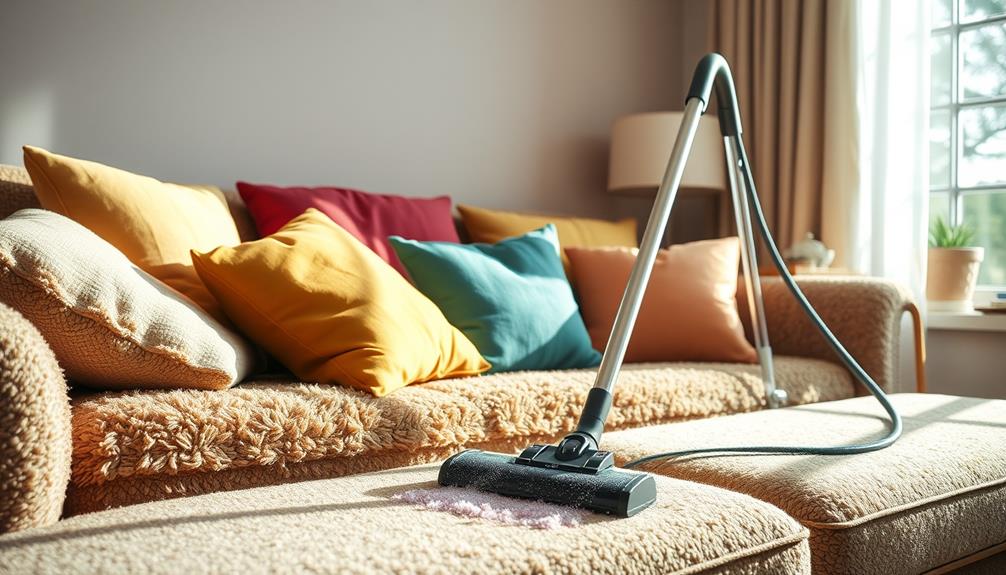
A thorough vacuuming session is essential for maintaining the cleanliness of your sofa upholstery. You should aim to vacuum your sofa at least once a month to remove dust, allergens, and debris that accumulate in fabric fibers and crevices.
Using a vacuum cleaner equipped with a HEPA filter is key; it captures more dust and allergens, ensuring a cleaner indoor environment for you and your family. Regular cleaning can also help you avoid the pitfalls of financial mistakes to avoid associated with neglecting home maintenance.
When you vacuum, pay special attention to the seams, cushions, and under the cushions, as these areas often harbor hidden dirt and debris. Don't forget to utilize a crevice tool to effectively clean between cushions and along the furniture frame, ensuring you reach those hard-to-access spots. This thorough approach guarantees that you leave no area neglected.
Additionally, tilt or move your sofa periodically to vacuum the bottom frame and the floor underneath. This area can collect dust and dirt too, contributing to an unclean environment.
Check Manufacturer Instructions
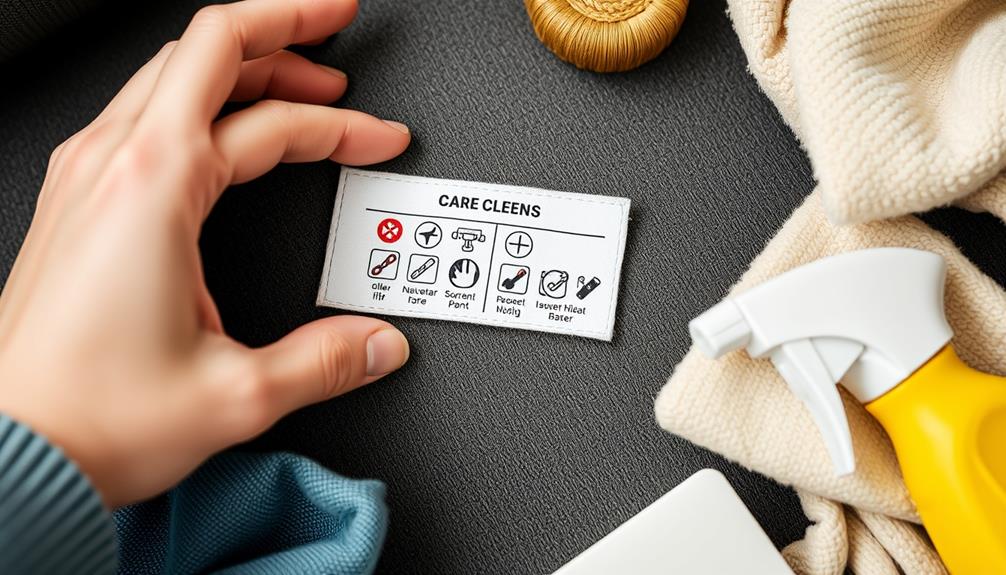
Before you start cleaning your sofa, make sure to check the care tag for specific instructions.
Understanding the cleaning codes will guide you on what methods and products are safe to use.
Additionally, using the right cleaning products can help maintain the longevity of your upholstery, similar to how regular maintenance can extend appliance lifespan considerably through preventive care appliance maintenance plans.
Following the manufacturer's recommendations not only protects your upholstery but also helps maintain any warranty you have.
Importance of Care Tags
When it comes to cleaning sofa upholstery, checking the care tags is crucial for preserving the fabric's quality. These tags provide essential information about appropriate cleaning methods, guaranteeing that you use the right cleaning agents for your specific fabric type.
Following the manufacturer's recommendations helps maintain the integrity of your upholstery and can greatly extend its life. Regularly consulting care tags can also enhance your cleaning effectiveness, similar to how fuel injection cleaning impacts performance.
Here are some key reasons why care tags are important:
- Cleaning Methods: Each fabric type has its specific cleaning method, indicated by codes such as W (water) or S (solvent).
- Preventing Damage: Using the wrong cleaning agents can harm your upholstery, so always refer to the care tags.
- Spot Testing: If a care tag is missing, conduct a spot test with a mild cleaner in a hidden area to avoid fabric damage.
- Regular Maintenance: Regularly consulting care tags guarantees that you're using the most effective cleaning techniques.
Understanding Cleaning Codes
Understanding cleaning codes is vital for anyone looking to maintain their sofa upholstery effectively. These codes indicate the appropriate cleaning methods for specific fabrics, guaranteeing you don't accidentally damage your upholstery. Common cleaning codes include W for water-based cleaning, S for solvent-based cleaning, WS for both, and X, which means vacuum only—no liquids.
Additionally, just as maintaining your toilet's flushing mechanism can extend its lifespan, proper care of your upholstery can greatly enhance its durability and appearance proper disposal habits.
Before you start cleaning, always check the care tag on your upholstery. This tag provides essential information about the safest cleaning methods for your fabric. If you can't find a care tag, it's wise to conduct a spot test in an inconspicuous area. This way, you can determine the safest cleaning approach without risking damage to the visible parts of your sofa.
Following the manufacturer's cleaning instructions is vital to preserving the integrity and appearance of your upholstery. By adhering to these cleaning codes, you confirm that you're using the right products and techniques to keep your fabric clean and looking its best.
Manufacturer Recommendations Compliance
Following the cleaning codes on your sofa's care tag is key to maintaining its appearance and longevity. Each code indicates the appropriate cleaning method, and ignoring these instructions can compromise the integrity of your upholstery.
Always refer to the manufacturer instructions to guarantee you're using the right technique. Understanding the financial aspects of maintaining furniture, especially for seniors, can also help in making informed decisions about cleaning and care. For more information, consider exploring financial aid resources that support elderly care.
Here are some essential points to remember:
- Care Tag Codes: Understand the codes like W (water), S (solvent), WS (both), or X (vacuum only).
- Cleaning Method: Use water-based solutions for fabrics labeled with a "W"; for "X," stick to vacuuming only.
- Spot Test: If your care tag is missing, do a spot test in an inconspicuous area to find the safest cleaning method.
- Cleaning Frequency: Follow any additional recommendations from the manufacturer regarding how often to clean to maintain your upholstery's appearance.
Spot Clean Stains Effectively

Effectively spot cleaning stains on your sofa can make a significant difference in maintaining its appearance. Start by addressing fresh liquid stains immediately. Use a clean microfiber cloth to absorb as much liquid as possible without rubbing, which might push the stain deeper into the fabric.
For water-safe fabrics, prepare a cleaning solution by mixing 1/4 cup dishwashing liquid with 1 cup of warm water. Gently rub the stain from the outside in with a sponge. Always perform a spot test on an inconspicuous area first to verify the cleaning solution won't damage or discolor the fabric.
For oil-based stains, apply an appropriate solvent according to the upholstery cleaning code, allowing it to dry completely before evaluating the results. If you're dealing with stubborn stains, consider steam cleaning, as the heat can loosen embedded dirt and make it easier to lift the stain without excessive scrubbing.
Here's a quick reference table for common stains and cleaning methods:
| Stain Type | Cleaning Method |
|---|---|
| Liquid | Blot immediately with a cloth |
| Water-based | Use dish soap cleaning solution |
| Oil-based | Apply appropriate solvent |
| Stubborn stains | Consider steam cleaning |
| General upkeep | Regular spot cleaning |
Use DIY Cleaning Solutions

You can easily tackle upholstery cleaning with common DIY ingredients found in your kitchen.
Effective cleaning methods like vinegar and baking soda can work wonders for various fabrics.
Additionally, incorporating essential oils can enhance your cleaning experience; for instance, using essential oils for a revitalizing scent can help create a pleasant atmosphere while cleaning.
Just remember to test any solution on a hidden area first to avoid unwanted damage.
Common DIY Ingredients
Cleaning your sofa upholstery doesn't have to break the bank; you can whip up effective DIY cleaning solutions right at home. Using common DIY ingredients, you can tackle stains, odors, and keep your upholstery looking fresh. Here are some great options:
- Vinegar and Water: Mix equal parts vinegar and water to create a potent cleaning agent that removes stains and neutralizes odors from fabric upholstery.
- Dish Soap Solution: Combine 1 teaspoon of dish soap with 1 gallon of warm water. Use a sponge to gently apply this mixture to stained areas, avoiding oversaturation to prevent water stains.
- Baking Soda: Sprinkle baking soda on your upholstery to neutralize odors. Let it sit for 15 minutes, then vacuum to remove both the baking soda and the absorbed smells.
- Olive Oil and Vinegar: For leather upholstery, mix equal parts olive oil and vinegar to clean and condition the surface, helping maintain its luster.
Always remember to perform a spot test on an inconspicuous area before applying any DIY cleaning solution to guarantee it doesn't damage your upholstery.
With these simple ingredients, you can easily clean your upholstery at home!
Effective Cleaning Methods
After gathering your DIY cleaning ingredients, it's time to put them to work with effective cleaning methods that can rejuvenate your sofa upholstery.
For general cleaning, mix 1 teaspoon of dishwashing liquid with 1 gallon of warm water. Use a microfiber cloth or sponge to apply the solution in small sections, ensuring you don't oversaturate the fabric.
To tackle stains on water-safe upholstery, create a vinegar solution of equal parts vinegar and water. Always test this mixture in a hidden area first to avoid damage.
For tougher stains, try a paste made from baking soda and water. Apply it directly to the stain, let it sit for a few minutes, then gently scrub before vacuuming.
To deodorize your upholstery, sprinkle baking soda on the cushions and let it sit for at least 15 minutes before vacuuming it up to eliminate odors.
If you're looking for a deep clean, consider steam cleaning. This method effectively loosens embedded dirt and stains without using harsh chemicals, making it a safe option for maintaining your sofa's appearance.
Deep Clean Your Upholstery
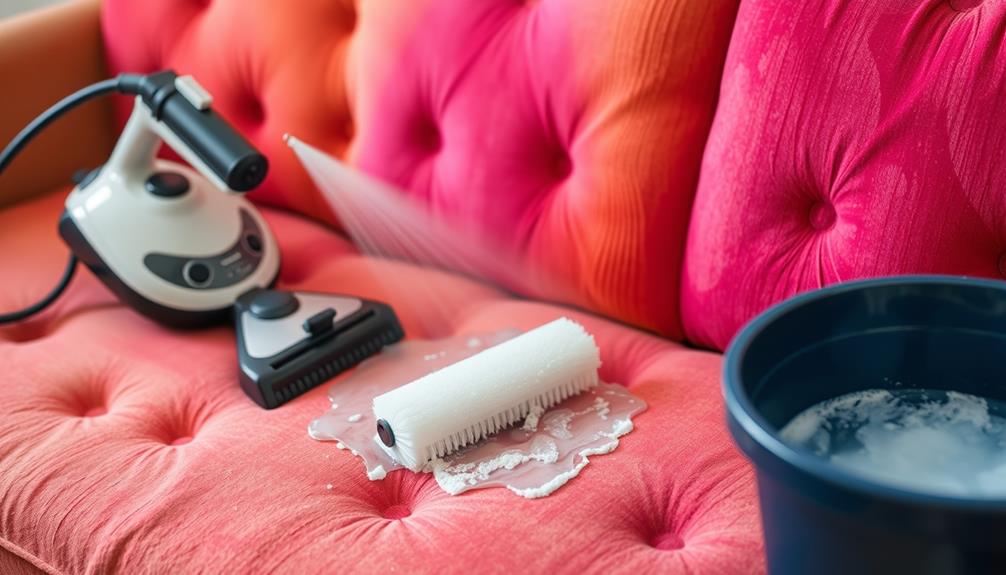
A deep clean can work wonders for your sofa's upholstery, removing dirt, allergens, and bacteria that accumulate over time. To keep your sofa looking fresh, aim for deep cleaning at least once or twice a year.
Start by thoroughly vacuuming the entire sofa, including crevices and beneath cushions, to remove dust and debris before applying any cleaning solutions.
Here's how to effectively deep clean your upholstery:
- Use a steam cleaner or a mixture of mild detergent and warm water on water-safe fabrics.
- Test any cleaning solution on an inconspicuous area first to avoid damage.
- For stubborn stains, try spot cleaning with a mix of vinegar and dish soap, using a soft bristle brush to gently blot the area until the stain lifts.
- After cleaning, allow the upholstery to air dry completely to prevent moisture buildup, which can lead to mold and mildew growth.
Deodorize With Baking Soda
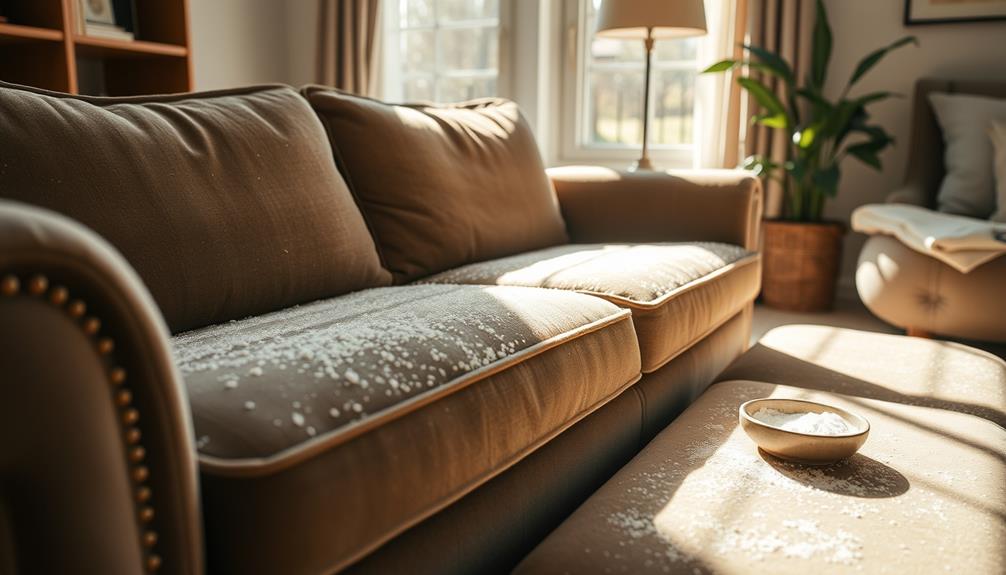
Deodorizing your sofa upholstery with baking soda is a simple yet effective way to eliminate unwanted odors. This natural deodorizer works wonders by neutralizing smells that can accumulate over time.
To get started, evenly sprinkle a thin layer of baking soda across your upholstery, giving extra attention to areas with noticeable odors. Allow it to sit for about 15-30 minutes, letting the baking soda absorb moisture and odors effectively.
After the waiting period, grab your vacuum cleaner with a brush attachment and thoroughly remove the baking soda. This step guarantees your sofa is fresh-smelling and clean, with no residue left behind.
If you're dealing with particularly persistent odors, consider mixing a few drops of essential oil with the baking soda before applying it. This adds a delightful scent to the mix, enhancing your cleaning routine.
Regularly using baking soda as a deodorizer can maintain a fresh environment in your home. By incorporating this simple method, you can keep your sofa upholstery looking and smelling great, while also guaranteeing it stays free from unwanted moisture and odors.
Allow for Proper Drying
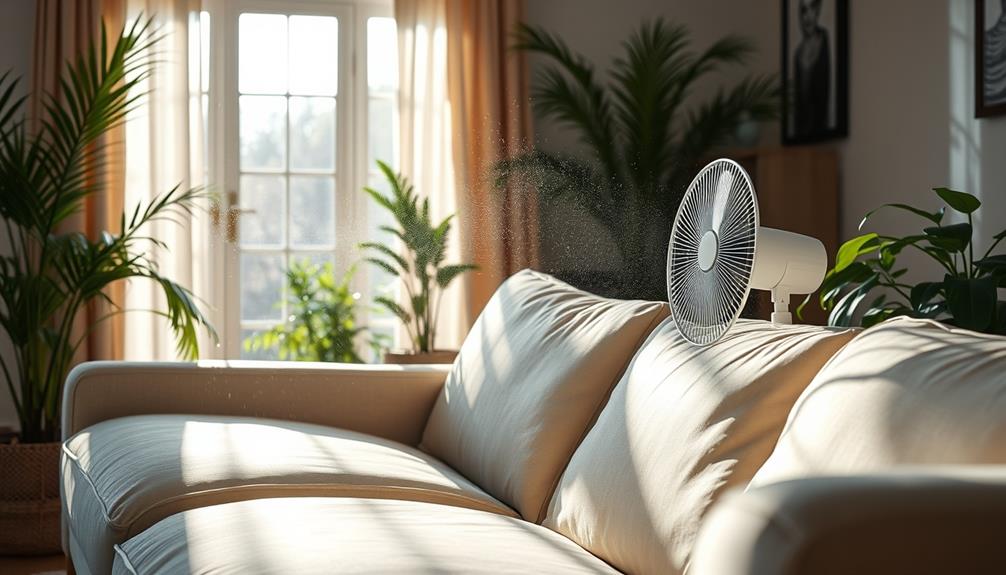
To guarantee your sofa upholstery remains in top condition, proper drying is essential after cleaning. Allowing your upholstery to air dry completely is vital to prevent mildew growth and maintain the fabric's integrity.
Here are some effective tips to make sure your upholstery dries properly:
- Use fans to expedite the drying process while keeping the area well-ventilated.
- Avoid using direct heat sources, like hair dryers or radiators, as they can damage the fabric and cause shrinkage.
- For thick or heavily soiled upholstery, use a towel to absorb excess moisture before letting it dry naturally.
- Regularly check for remaining dampness in hidden areas, such as under cushions, to verify thorough drying has occurred.
Schedule Regular Maintenance

While maintaining your sofa upholstery might seem challenging, scheduling regular maintenance can make a significant difference in its longevity and appearance.
Start by scheduling vacuuming at least once a month to prevent dirt buildup that can wear down the fabric. If you have pets, you might want to increase this frequency to keep hair and dander at bay. Incorporate weekly maintenance routines using a lint roller or brush to remove surface debris and keep your upholstery looking fresh.
Additionally, plan for a deep clean every 12 to 18 months, or more often if your sofa sees heavy use or if you have pets. This process will help eliminate stubborn stains and odors effectively. Regularly assess your sofa for any signs of stains or odors, and address them immediately. A proactive approach will maintain a clean and inviting living space.
Consider establishing a cleaning schedule that aligns with the seasons, such as deep cleaning during spring and fall. This guarantees thorough maintenance throughout the year and keeps your upholstery in top shape, enhancing your home's comfort and aesthetic.
Frequently Asked Questions
What Is the Best Way to Clean a Fabric Sofa?
To clean a fabric sofa, check the care tag for instructions, vacuum regularly, and use a gentle cleaning solution. Blot spills immediately and consider professional cleaning every couple of years for ideal care.
How Do You Clean a Fabric Couch Without Washing It?
Cleaning a fabric couch without washing it's like taming a wild beast. Start by vacuuming thoroughly, then spot clean stains with a soapy mixture. Finish up with a steam cleaner for a fresh, revitalized look.
What Is the Best Homemade Upholstery Cleaner?
The best homemade upholstery cleaner combines 1/4 cup dishwashing liquid with 1 cup warm water. This mixture lifts dirt effectively without harming fabrics, making it an excellent choice for your cleaning routine. Give it a try!
What Do Professionals Use to Clean Upholstery?
Imagine a team armed with powerful steam cleaners, specialized detergents, and vacuum systems. They plunge into your upholstery, banishing dirt and allergens, ensuring it looks pristine while safeguarding delicate fabrics with gentle care. You'll feel the freshness!
Conclusion
By following these steps, you can keep your sofa looking fresh and inviting, like a well-tended garden in full bloom. Regular maintenance and prompt attention to spills will help preserve the beauty of your upholstery. Remember, a clean sofa not only enhances your space but also creates a welcoming atmosphere for family and friends. So, roll up your sleeves and give your sofa the care it deserves, ensuring it remains the heart of your home.
